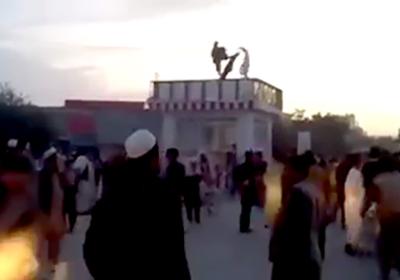Despite consistent pressure on Kunduz over the past six months, its collapse was unexpected. But it happened and shocked the nation.
At this stage when government and media speak out about the victory of security forces over the Taliban in Kunduz city, the reality shows that the Taliban militants are more capable now than they have ever been in the northeast. In an unprecedented move they have destabilized four north-eastern provinces. The government is so busy dealing with the Kunduz city collapse that the fall of other districts does not even make headlines.
Unhappy People
Kunduz is a clear example of mismanagement and a corrupt government. No attention was paid to the government when the country was under threat of insurgents during both the spring and summer seasons.
fficials from the central government traveled to the province several times, however, the dream of locals to have a reformed local government never came true.
Video footage and pictures, which came through social media on the first day of the fall of Kunduz city, revealed how people were careless in the lead up to the collapse of their city to the Taliban – this because of the gap between government and people. Footage now shows the lowest level of public support to the government. On the first night under Taliban control, a few Kunduz city residents came out to the only roundabout in the city and chanted pro-Taliban slogans. It can be expected that they did so either out of fear of the insurgents or because there were only a few local Taliban supporters; however, what was apparent was their lack of support to the government. This celebration happened at a time when the Taliban death squads were busy killing people and raping women in other parts of the city. Such crimes committed last week by the Taliban were flashbacks to 9/11.
Beyond The Expectations
Most analysts and intelligentsia believe that the Taliban – after murdering targeted individuals, looting and destroying the city and damaging the image of the Afghan government – would return to their hideouts on the outskirts of Kunduz city, but later their strategy was proven otherwise.
The casualty toll on the Taliban by troops was high. However the Taliban were not ready to give up the city easily. But why was the Taliban bent on extending the battle? By this, on one hand, they wanted to increase the cost of war and make the security forces exhausted while on the other, they wanted to change people's mindsets against the security forces.
However, the Afghan National Defense Force (ANDF) and Afghan National Security Forces (ANSF) have garnered wide support by media and social media users from all over Afghanistan. Some social media users post security forces' pictures and name them as heroes and guards of the country. The situation changed after the battle was prolonged in Kunduz city. People now expect the security forces to ensure their security.
They would face mounting criticism from the residents if they failed to restore security in Kunduz. Civilian casualties caused by an airstrike during a joint military operation by the Afghan and Resolute Support forces on a hospital in Kunduz can also harm the security forces' image and can reduce public trust in them. It seems that it will not be important for Kunduz residents as to who controls the city; what is more important for them is to have their lives secured – this is what happened during the Taliban's entrance to Kabul in 1996.
In addition to raising fingers towards the weakness of the government, the question on what the Taliban is looking for also needs to be asked. To answer this, there have been several theories:
Local Rivalries
A number of analysts have continuously said that the rivalries among the local forces have resulted in war and insecurity in Kunduz. It is said to be one of the main reasons behind rifts between the president and the chief executive of the National Unity Government.
Some believe that such rivalries, the rivals have even avenged their old enmity during the war era. This rivalry among some local commanders has even further expanded, and has turned into hostility among different ethnic groups.
One side blames the former commanders of Hezb-e-Islami party for using the local police force for their benefit while the other side blames former president Hamid Karzai's chief of staff, Karim Khurram, for arming Hezb-e-Islami supporters in Kunduz and that now these armed individuals are fighting the security forces and the government. Mir Alam Khan, a former Jihadi leader confirmed this in a chat with TOLOnews.
Now, according to reports by media and the government, Taliban militants have seized weapons and military vehicles in the province. They looted at least $8 million USD from banks during their first night attack on Kunduz city. Such facilities help prolong the war.
These rivalries, in fact, are apparently turning into a tribal war – the war between Pashtuns and non-Pashtuns, but the other façade of the war is that there are non-Pashtun and even foreign nationals from central Asia are among the Taliban fighters. On the other hand the security forces that are fighting the insurgents in the province are from all tribes and ethnic groups in the country. Footage shows that Pashtun forces have killed Taliban fighters. The logic of tribalism is questioned by such an argument but the cause of local rivalries still exists. The Taliban are trying to make this an ethnic-based war.
Central Asia
A video of a Taliban fighter that went viral on social media reveals the insurgent group's beyond-border goals. He apparently says that they will erect their flag not only in Kunduz but also in Bukhara, Chechnya and Caucasus. Security officials have confirmed that there were Pakistani, Chechen, Arab and Central Asian citizens among the fighters killed or captured.
Reports by media and international organizations such as the International Crisis Group reveal that Daesh – Islamic State or ISIS – has already made a footprint in central Asia. The reports say that at least 5,000 Central Asian residents are fighting for Daesh in Iraq and Syria and that there is a possibility of their return to their region.
On the other hand, the Fergana Valley which is part of Kyrgyzstan, Tajikistan and Uzbekistan, has reportedly turned into a recruiting center for Daesh fighters. Islamic Movement of Uzbekistan (IMU) which has failed to make a footprint in central Asia pledged allegiance to Daesh last year and is currently recruiting people for the group in Fergana Valley.
The central Asian governments, each, have separately asked for international support to fight Daesh and extremism. Tajikistan which has the closest ties with Russia, has received military support worth $2 billion USD from that country. Uzbekistan has also received hundreds of armored vehicles from the US to thwart any threat by terrorism. The Prime Minister of Kyrgyzstan has also called on the European Union to help it in tackling Daesh.
But the most vulnerable border in central Asia is the border between Tajikistan and Afghanistan which is 1,344 kms long –1,135 kms is a river and the remaining 189 kilometers is land. Low levels of water in the Oxus River in parts of northeastern Badakhshan province of Afghanistan makes it easy to for insurgents to cross the Tajikistan border. Moreover, deep canyons in the area, which connects Pakistan with Afghanistan and central Asia, has created a suitable route for fighters to travel to Afghanistan from Pakistan and vise-versa.
Taliban and central Asian fighters reach northeastern Afghanistan through Badakhshan Mountains from Pakistan and pose a threat to Tajikistan borders.
A number of analysts believe that the dispute between the U.S and Russia over the Ukraine and Syria would result in insecurity in Russia's southern borders. Russia's recent air strikes on anti-Bashar-al-Assad fighters will create a new wave of Islamic extremism against Russia and it is possible that such a wave could stand against Russia in Caucasus and central Asia. Such an argument is worth discussing in that framework.
Preventing The Lines
President Ashraf Ghani in a meeting with a number of Kunduz elders and residents meanwhile brought up another issue. He said the main reason behind Kunduz war is preventing the railroad project between Turkmenistan-Afghanistan-Tajikistan. Besides that, he said that the militants, at the same time when CEO Abdullah Abdullah was addressing the UN General Assembly, wanted to show Afghanistan as an insecure and unstable country so that it could make the international community despondent about Afghanistan.
Although Ghani did not mention clearly who was behind such a plot, the government of Afghanistan usually blames Pakistan in such cases.
The issue that cannot be debated in this piece is the defeat of security forces in Kunduz in terms of military and intelligence. It means that if the Afghan government is paying importance to the railroad, then it should have taken concrete security measures for it. But with prolonging of war each day, it seems that there were Taliban fighters hiding in each and every part of Kunduz and now they have come out and engaged in the conflict. How could the intelligence and military agencies of Afghanistan not have uncovered such movement and plans by the Taliban? If they were discovered, why did they not take any measure to prevent this?
Ghani has repeatedly said that Kunduz is his top priority. That's why the first governor he appointed was for Kunduz. But the province has been vulnerable in the past year and its residents have been unsatisfied during this period. Such a situation has not been limited to Kunduz; today, it has affected the entire north-eastern zone. It means that the threats will extend to the entire zone if not prevented. There is no sign of a strict response by the Central Asia and the powerful force there – the Russian force – in this regard so far. However, what is evident is Ghani has wrong policies and plans.
The question then remains - does he still have the chance to review his plans?



Comment this post